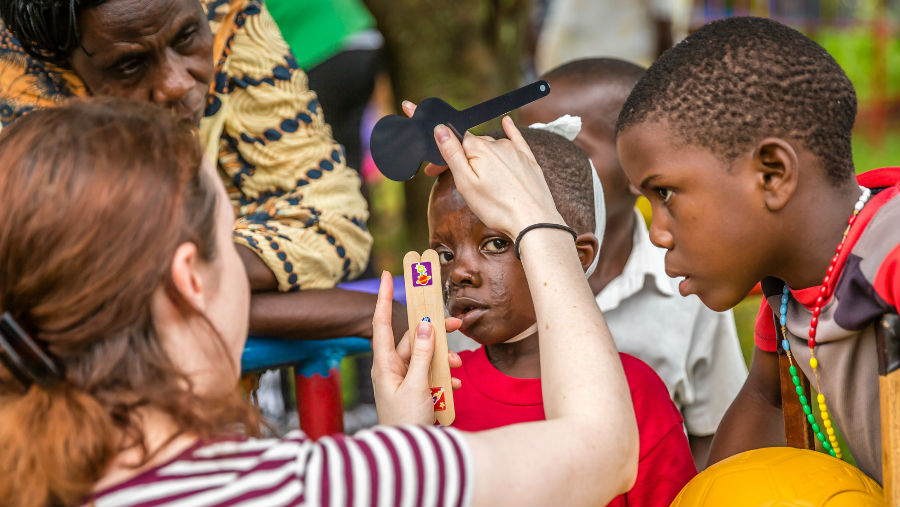 |
|
Globally, efforts in the past three decades have substantially decreased the burdens of blindness and vision loss among children and adolescents. Photo: Int'l Agency for the Prevention of Blindness. |
The World Health Organization estimates that 1.4 million children worldwide are blind, 17.5 million suffer from moderate to severe visual impairment and 18.9 million have general visual impairment. Data is lacking on the prevalence rates of different types of vision loss and the overall years lived with disability (YLDs) associated with the disease burden among children and adolescents worldwide. In a recent study, researchers provided global estimates for global, regional and national burdens of blindness and vision loss among children and adolescents between 1990 and 2019 by disease, age and sociodemographic index (SDI).
The population-based study used 1990 to 2019 data on the burden of vision loss and blindness from the Global Burden of Diseases (GBD), Injuries and Risk Factors Study 2019. The burden of vision loss and blindness was evaluated in terms of case numbers, rates per 100,000 population and average annual percentage changes in prevalence rates and YLDs.
Globally, the rates of blindness and vision loss per 100,000 people decreased in all age groups between 1990 and 2019, with prevalence rates falling from 1091.4 to 1036.9 and YLDs decreasing from 44.5 to 40.2.
“We found that the prevalence of near vision loss among cases of eye-specific diseases increased, similar to the findings of a previous GBD study (from 1990 to 2017),” the study authors wrote in their paper. Notably, although the burden of YLDs due to blindness and vision loss also declined, we found no significant decrease in the refractive disorder burden.”
The prevalence and YLD rates and their associated trends increased exponentially with increases in the SDI, which is consistent with results from the GBD 2017. Two main hypotheses have been proposed regarding these relationships: lifestyle changes, such as the excessive use of electronic devices, and fewer outdoor activities are common in wealthy countries, and high-income countries may better provide coordinated and cost-effective health services for individuals.
“The GBD 2017 indicated that Israel had the highest YLD rate after adjustment for population size, while Barbados and Sweden had the lowest YLD rates,” the authors explained. “In contrast, we found that Oman had the highest YLD rates of blindness and vision loss and that Burundi had the lowest YLD rates in 2019. At the regional and country levels, high income countries in North America and, specifically, the United States had the greatest upward trends in terms of both prevalence and YLD rates from 1990 to 2019.”
Two other data analyses from the 2009 to 2017 National Health Interview Survey (NHIS) suggested that there were no significant changes in blindness prevalence among US children aged three to 17 years old. “Although direct comparisons to these studies were not possible due to differences in data sources and applied methodologies, we observed inconsistent findings,” the authors explained. “Additionally, the United States admitted over 80,000 Special Immigrant Visa (SIV) holders, including children, until 2019. A cross-sectional study among SIV children (younger than 18 years old) from Iraq and Afghanistan from 2009 to 2017 indicated that nearly 4% had vision abnormalities. Although this is only a conjecture, the rising burden of childhood vision loss in the United States may be at least partially due to SIV holders. This phenomenon deserves attention.”
Although cumulative global efforts have significantly decreased the burden of blindness and vision loss among children and adolescents over the past three decades, increases in the burden of near vision loss merit attention, the authors noted. Future efforts to alleviate blindness and vision loss in this population (zero to 19 years old) involve targeting specific kinds of impairment, age groups and countries according to the SDI.
“Expanding eyecare services in terms of both screening coverage and quality control can reduce the vision loss burden among premature infants in lower SDI regions and among children with excessive near work or reduced outdoor activities in higher SDI regions,” the authors concluded.
Liu L, Jiao J, Yang X, et al. Global, regional and national burdens of blindness and vision loss in children and adolescents from 1990 to 2019: a trend analysis. Ophthalmology. February 1, 2023. [Epub ahead of print]. |


